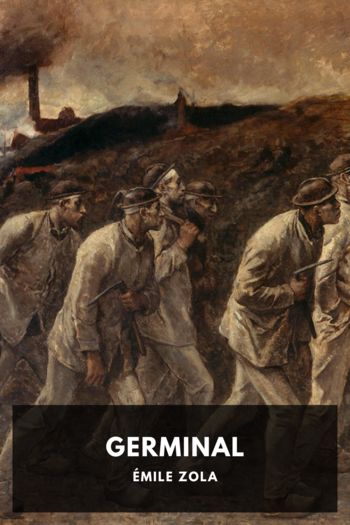His Masterpiece Émile Zola (e textbook reader TXT) 📖

- Author: Émile Zola
Book online «His Masterpiece Émile Zola (e textbook reader TXT) 📖». Author Émile Zola
Nevertheless, Christine had so far objected to be accompanied farther than the Mail. At the Quai des Ormes she always bade Claude go back, as if Paris, with her crowds and possible encounters, began at the long stretch of quays which she had to traverse on her way home. But Passy was so far off, and she felt so dull at having to go such a distance alone, that gradually she gave way. She began by allowing Claude to see her as far as the Hôtel de Ville; then as far as the Pont-Neuf; at last as far as the Tuileries. She forgot the danger; they walked arm in arm like a young married couple; and that constantly repeated promenade, that leisurely journey over the selfsame ground by the river side, acquired an infinite charm, full of a happiness such as could scarcely be surpassed in after-times. They truly belonged to each other, though they had not erred. It seemed as if the very soul of the great city, rising from the river, wrapped them around with all the love that had throbbed behind the grey stone walls through the long lapse of ages.
Since the nipping colds of December, Christine only came in the afternoon, and it was about four o’clock, when the sun was sinking, that Claude escorted her back on his arm. On days when the sky was clear, they could see the long line of quays stretching away into space directly they had crossed the Pont Louis-Philippe. From one end to the other the slanting sun powdered the houses on the right bank with golden dust, while, on the left, the islets, the buildings, stood out in a black line against the blazing glory of the sunset. Between the sombre and the brilliant margin, the spangled river sparkled, cut in twain every now and then by the long bars of its bridges; the five arches of the Pont Notre-Dame showing under the single span of the Pont d’Arcole; then the Pont-au-Change and the Pont-Neuf, beyond each of whose shadows appeared a luminous patch, a sheet of bluish satiny water, growing paler here and there with a mirror-like reflection. And while the dusky outlines on the left terminated in the silhouettes of the pointed towers of the Palais de Justice, sharply and darkly defined against the sky, a gentle curve undulated on the right, stretching away so far that the Pavillon de Flore, who stood forth like a citadel at the curve’s extreme end, seemed a fairy castle, bluey, dreamlike and vague, amidst the rosy mist on the horizon. But Claude and Christine, with the sunlight streaming on them, athwart the leafless plane trees, turned away from the dazzlement, preferring to gaze at certain spots, one above all—a block of old houses just above the Mail. Below, there was a series of one-storied tenements, little huckster and fishing-tackle shops, with flat terrace roofs, ornamented with laurel and Virginia creeper. And in the rear rose loftier, but decrepit, dwellings, with linen hung out to dry at their windows, a collection of fantastic structures, a confused mass of woodwork and masonry, overtoppling walls, and hanging gardens, in which coloured glass balls shone out like stars. They walked on, leaving behind them the big barracks and the Hôtel de Ville, and feeling much more interest in the Cité which appeared across the river, pent between lofty smooth embankments rising from the water. Above the darkened houses rose the towers of Notre-Dame, as resplendent as if they had been newly gilt. Then the secondhand bookstalls began to invade the quays. Down below a lighter full of charcoal struggled against the strong current beneath an arch of the Pont Notre-Dame. And then, on the days when the flower market was held, they stopped, despite the inclement weather, to inhale the scent of the first violets and the early gillyflowers. On their left a long stretch of bank now became visible; beyond the pepper-caster turrets of the Palais de Justice, the small, murky tenements of the Quai de l’Horloge showed as far as the clump of trees midway across the Pont-Neuf; then, as they went farther on, other quays emerged from the mist, in the far distance: the Quai Voltaire, the Quai Malaquais, the dome of the Institute of France, the square pile of the Mint, a long grey line of frontages of which they could not even distinguish the windows, a promontory of roofs, which, with their stacks of chimney-pots, looked like some rugged cliff, dipping down into a phosphorescent sea. In front, however, the Pavillon de Flore lost its dreamy aspect, and became solidified in the final sun blaze. Then right and left, on either bank of the river, came the long vistas of the Boulevard de Sebastopol





Comments (0)